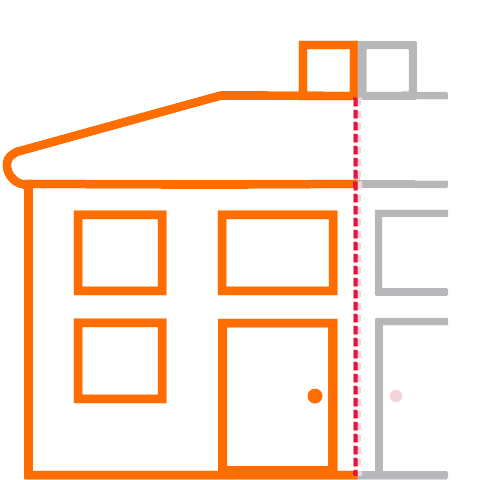You should remove old loft insulation before installing new material if it's over 80 years old, shows signs of damage, or contains hazardous materials like asbestos. Key indicators that replacement is necessary include visible water stains, mold growth, compression, pest infestations, or excessive dust accumulation. While basic removal services typically cost between £300-£800, the long-term energy savings from new insulation can offset this initial investment. Professional assessment is essential to evaluate the condition of existing insulation and identify any health hazards requiring specialized handling. Understanding the complete removal process will help you make an informed decision about your insulation project.
Age of Existing Insulation
Table of Contents
ToggleBefore replacing your loft insulation, checking the age and condition of your existing material is essential. While high-quality insulation materials can last between 80 to 100 years under ideal conditions, you'll need to determine if your current insulation falls within this timeframe to make an informed decision about replacement.
If you've found that your insulation is approaching or has exceeded the 80-year mark, you should strongly consider removing it, as its performance may have considerably degraded over time.
Even if your insulation hasn't reached this age threshold, you'll want to evaluate its current state, as various factors can impact its effectiveness. The accumulation of dust and debris throughout the decades can compromise the insulation's performance, making removal necessary before installing new material.
Additionally, you'll need to inspect for signs of deterioration, such as water damage, mold growth, or physical compression, which are clear indicators that the old insulation should be removed.
A thorough assessment of your existing insulation's age and condition will help you determine whether it's time for a complete replacement or if you can safely add new insulation over the existing layer.
Signs of Damaged Insulation
When inspecting your loft insulation, several telltale signs can indicate damage that requires immediate attention. You'll need to look for visible water stains or the presence of mold, as these typically signal underlying moisture problems that can severely compromise your insulation's effectiveness. If you notice these issues, they're often linked to leaks or condensation problems that need addressing.
Physical deformation is another significant indicator you shouldn't ignore. When your insulation appears compressed, squashed, or has started to slump, it's likely lost its ability to trap air effectively, reducing its insulative properties.
You'll also want to watch for signs of unwanted visitors – rodents and insects can cause significant physical damage to your insulation materials, necessitating removal and replacement of affected sections.
Additionally, if you're seeing excessive dust or debris accumulation in your insulation, this can lead to saturation and decreased performance.
While quality loft insulation can last up to 100 years when properly maintained, any of these signs of deterioration warrant a thorough assessment. It's important to remember that compromised insulation won't provide the thermal protection your home needs, potentially leading to increased energy costs.
Health and Safety Considerations
Removing old loft insulation can pose serious health risks if proper safety precautions aren't taken. Before you begin any removal work, you'll need to identify the type of insulation present, as certain materials like asbestos require specialized handling by certified professionals due to their hazardous nature.
You must equip yourself with appropriate protective gear, including safety goggles, respiratory masks, and heavy-duty gloves, to shield yourself from harmful particles and potential allergens.
When you're working in the loft space, guarantee proper ventilation to minimize the concentration of airborne particles that could affect your respiratory health. You'll also need to implement effective dust control measures to prevent the spread of debris throughout your home.
Prior to removal, you should carefully inspect the insulation for signs of pest infestations, as rodent or insect presence can create biohazardous conditions that require additional safety protocols.
If you're unsure about handling the removal safely, it's advisable to contact professional contractors who can manage the process while adhering to necessary health and safety regulations, protecting both you and the environment from potential harm.
Cost Implications
The financial impact of loft insulation removal deserves careful consideration before starting your project. You'll need to budget between £300 and £800 for basic removal services, though your exact costs will depend on your loft's size and the insulation type you're dealing with.
When you're facing damaged or contaminated insulation, you'll likely encounter higher expenses due to the necessity of professional intervention. This is particularly true if there's asbestos present, as contractors will charge additional fees for the proper handling and disposal of hazardous materials.
However, you shouldn't let these initial costs discourage you, as the long-term energy savings from new, properly installed insulation can help offset your investment over time.
It's worth investigating potential financial support before proceeding with your project. You might find that your local authority offers grants or subsidies specifically for insulation improvements. Additionally, some energy efficiency programs provide financial incentives that could help reduce your out-of-pocket expenses.
Professional Assessment Guidelines
Before undertaking any loft insulation removal, you'll need a thorough professional assessment to determine the scope and safety requirements of your project.
A qualified contractor will evaluate your existing insulation's condition, checking for signs of damage, deterioration, or compromised effectiveness that might necessitate removal before installing new material.
During the assessment, you'll receive vital information about your insulation's remaining lifespan, as most materials serve effectively for 80 to 100 years.
The inspector will specifically look for hazardous materials, such as asbestos, which require specialized removal procedures and safety protocols.
They'll also examine the insulation for signs of pest infestation or moisture damage, both of which can markedly impact its performance and potentially create health risks in your home.
By engaging a professional, you're ensuring compliance with safety regulations while getting expert guidance on proper disposal methods for any hazardous materials identified.
This evaluation isn't just about determining whether removal is necessary; it's about creating a thorough plan that addresses safety concerns and meets regulatory requirements, ultimately protecting both your home and its occupants.
Disposal Options
Once you've decided to remove your old loft insulation, you'll need to contemplate several disposal options based on the material type and condition. Your first step should be determining whether your insulation contains hazardous materials, particularly asbestos, as this will greatly impact your disposal approach.
If you're dealing with non-hazardous materials, you'll find that household waste recycling centers often accept old insulation, providing a cost-effective disposal solution.
However, if you're unsure about the material composition or prefer a hands-off approach, you can hire professional contractors who'll handle the entire removal and disposal process for a fee. These experts will guarantee compliance with local regulations and proper disposal protocols.
For insulation containing asbestos, you'll need to engage licensed specialists who are qualified to handle hazardous materials.
Don't attempt to dispose of asbestos-containing materials yourself, as improper handling can pose serious health risks.
Professional assessment services can help you identify your insulation type and recommend appropriate disposal methods, making sure you're following all safety guidelines and regulatory requirements while protecting yourself and the environment.
Energy Efficiency Impact
While many homeowners hesitate to remove old loft insulation, keeping deteriorated materials in place can severely impact your home's energy efficiency. When your existing insulation becomes damaged or degraded, you'll experience significant heat loss and cold air infiltration, resulting in unnecessarily high energy bills.
The presence of dust, moisture, and debris in aging insulation can reduce its effectiveness by up to 50%, compromising its ability to maintain consistent temperatures throughout your home.
You won't achieve ideal energy efficiency by simply laying new insulation over compromised materials. The underlying damaged insulation will continue to undermine your home's thermal performance, preventing you from realizing the full benefits of your investment.
If you're planning to upgrade your loft insulation, you'll want to remove old materials that show signs of physical deformation or pest damage first. By starting with a clean slate, you'll position yourself to maximize the potential energy savings, which can range from 10% to 50% on your heating and cooling costs.
This thorough approach guarantees your new insulation will perform at its peak efficiency, delivering the energy-saving results you're seeking.
Installation Best Practices
Successful installation of new loft insulation hinges on proper assessment and preparation of your existing materials.
You'll need to thoroughly inspect your current insulation for signs of moisture damage, mold growth, or pest infestations that could compromise your new insulation's performance. If you uncover wet, compressed, or contaminated sections, you'll need to remove them before proceeding with the installation.
Before adding new layers, you should verify the age of your existing insulation, as materials that have exceeded their 80-100 year lifespan won't provide adequate support for new insulation.
Additionally, you'll need to guarantee proper ventilation throughout your loft space, checking that the old insulation isn't blocking any vents that could lead to condensation issues.
When you're ready to proceed, strictly follow the manufacturer's installation guidelines to achieve ideal results.
While you can tackle this project yourself, consulting a professional is recommended, particularly when dealing with older materials that may require special handling.
They'll ensure your new insulation is correctly layered and properly sealed, maximizing its thermal efficiency and extending its functional lifespan.





